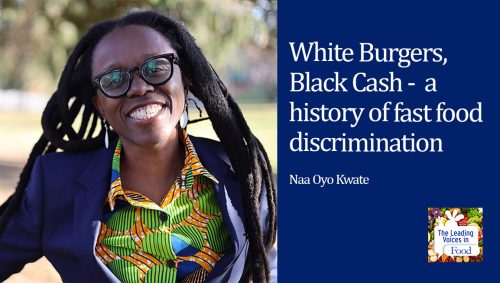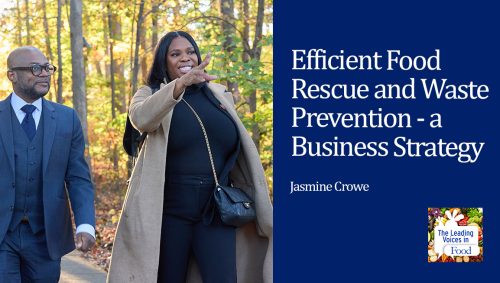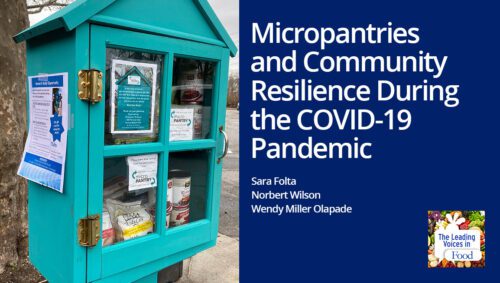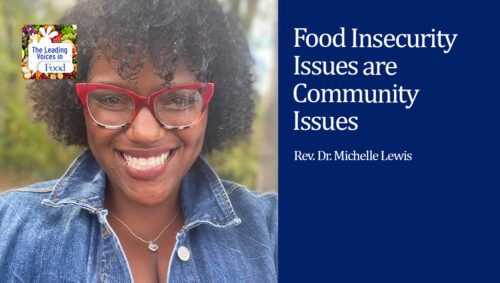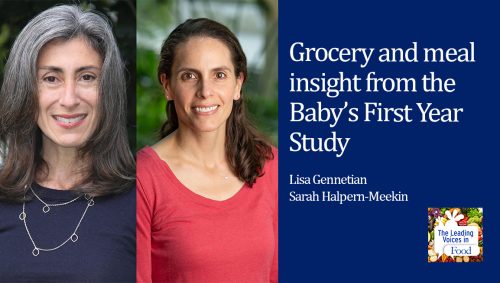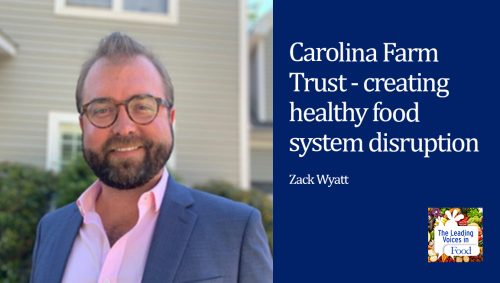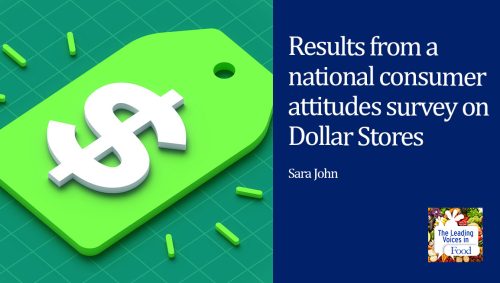The Leading Voices in Food
E66: Jeremy Everett: Ending Hunger Takes Coordinated Action
Faith-based efforts can be powerful and compelling ways to address a number of social issues, including food insecurity.
Subscribe: Apple Podcasts | TuneIN | Google Podcasts | SoundCloud | PocketCasts | Radio Public
Tags: Equity, Race & Food Justice | Faith & Food | Food Insecurity | Philanthropy & Food Systems |

Jeremy Everett is the founder and executive director of the Texas Hunger Initiative, a capacity-building, anti-hunger project within Baylor University, and is a senior fellow with World Hunger Relief, and was appointed by the U.S. Congress to serve on the National Commission on Hunger. He has authored important pieces on food insecurity, including his book entitled, I Was Hungry: Cultivating Common Ground to End an American Crisis.
Interview Summary
Jeremy, I’m so pleased that you can join us today and I look forward to hearing about the Texas Hunger Initiative. But let me begin with several other questions if I could. Who experiences hunger and food insecurity in America?
Well, that is a great question. Unfortunately, I think too often, we like to pretend that people who are food insecure are oftentimes people that are just unwilling to take personal responsibility for their own situation, thus don’t have enough to eat. The reality of food insecurity in the U.S. is that it’s episodic, meaning that most people who experience food insecurity experience it at some point or time in a given month, typically towards the end of a pay period. And the number one reason that people experience food insecurity in the U.S. is underemployment, basically meaning that they have jobs and are working, but they’re oftentimes not making enough money to make ends meet. So if you have medical expenses or anything else, a car payment or childcare expenses, you’re probably not going to be able to cover your entire cost. So underemployment is the primary thing that we see.
Second thing is educational attainment. Unfortunately, if you experience hunger or live in an impoverished community or live in an impoverished household, the chances of graduating from high school are really stacked against you. But ironically, if you live with hunger or in poverty, you need to graduate from high school and get an additional degree if you’re going to break the cycle. And so educational attainment is an issue that we see prevalent among causes related to hunger. And then a third issue is race. Here we are in 2019, and you’re still twice as likely to experience food insecurity if you’re a person of color.
So given what you’ve just said, you can see that vast numbers of people are affected by the problem, that the consequences are pretty devastating and that the cycle can be very difficult to interrupt, but important to interrupt. And so many people and organizations are working to address food insecurity, not only in the U.S. but around the world. What special role do you see for faith-based efforts and how does religion fit into this idea of addressing food insecurity?
What we know is that all major religious traditions talk about addressing hunger as a moral imperative. So my book, I Was Hungry, was titled from the text and in Matthew 25 where Jesus in this situation … This is the only apocalyptic or eschatological scene in the Gospel of Matthew, and he’s gathered all people before him and he’s determining who gets into the kingdom of God. So he begins to separate people, the sheep from the goats. The goats are the ones that did not feed the hungry and provide shelter to the stranger. Instead, the people who he welcomes into his kingdom are those that did, and he even calls people who are hungry members of his own family.
I think what we know from that text oftentimes is that we treat these issues, and most faith traditions do this, we treat these issues as ancillary or almost relegate them to extra credit. If you do that, then good for you, but it’s certainly not something that we’re required to do. But in this particular text, Jesus certainly tells people of faith that this is what it’s all about. It all hinges upon if you fed the hungry and clothed the naked and provided shelter to the stranger.
I think what we know in terms of pragmatically, then, about people in faith communities, so beyond the fact that we’re responsible for addressing it, is that in Texas alone, we have over 4,000 organizations that are predominantly faith-based doing something about hunger. The need is huge, but we also have a compassionate response. But oftentimes, churches and congregations of all stripes choose to address these social issues unilaterally. And they’re not working with their local government or local schools. They’re doing things independently of other congregations.
And so what we believe is that hunger and poverty are too big for any one sector to address by themselves, and the only way that we’re going to make systemic change on a local level or a state level or even a global level, is to get all of these groups working in concert with each other. So faith communities play a critical role in the nation, both in terms of framing our understanding of our moral responsibility, but then also being the feet on the ground.
It’s nice to hear how your own faith and your own faith tradition has helped address this issue of food insecurity, but also to know that other religions are tackling it in similar ways. What experiences have you had that helped shape your perspective on how to address food insecurity?
So much of my work was informed by particularly those civil rights leaders who believed in incarnational organizing, essentially that you needed to have proximity to the problem. So for most of the last 20 years or two decades of my life, I’ve lived in these low income neighborhoods where we’ve been working. And one seminal experience that I had while living on the west side of San Antonio was one of our neighbors, a woman named Liz, neighborhood of about 150,000 residents, all with a median income of about 19,000 per household and typically about three generations living in a household together, and that was certainly true in Liz’s case.
She and her husband were devout Catholics and had eight children all in school, all school age, and she knew the ticket out of poverty for her kids was for them to graduate from high school and go to college. Now, the high school that they were going to, her older kids, had over a 50% dropout rate and college readiness was in the single digits, and so Liz knew that she needed to volunteer not only to help her kids out, but also to help the other kids out in the community. So every day, she had two wheelchair-bound parents that lived with her, so she would get them situated and send them off to an adult daycare facility. Her husband was away at work. Liz would make her way down to the schools to volunteer, was just a huge contributing member of that community, a real inspiration.
Well, Liz got an ear infection, but they didn’t have health insurance, as most members in our community did not. They also experienced food insecurity. Her husband’s job didn’t pay enough to cover all their bills and so it wasn’t uncommon for she and her family to run out of food towards the end of the month. They didn’t have great transportation. Liz, when she got an ear infection, waited until it got incredibly painful and decided to catch the bus and go down to one of the downtown emergency rooms in San Antonio.
She sat in the waiting area waiting to be seen all day and they never called her name and she knew she needed to catch the bus to get back home before her younger kids got out of school. So when she did, she got back home and later that evening, her ear drum ruptured, the infection went through her brain, she fell into a coma and she never woke up. I remember sitting on the front porch with her husband the next day. He was going around the block trying to raise money for a memorial service for Liz, and he just had his head buried in his hands just saying, “What am I going to do? What am I going to do?”
Because many of us are professionals in a particular aspect of the justice community, so you have people that work on the hunger issue and people that work on the healthcare issue and people that work on housing issues and so on and so forth, and then we’ll hear numbers that are spouted by folks that say there are 40 million Americans that are food insecure and 40 million Americans that are living in poverty and another 30 million Americans that don’t have access to healthcare and so forth, and we treat those as if those are different segments of the population, as if each segment that is mentioned is dealing with that one isolated issue.
But the reality is, it’s the same family on the local level that are bearing all of the burdens of our broken social systems. They are food insecure, they don’t have healthcare, are having a hard time being able to pay rent or a car payment, they’re sending their kids to underperforming schools and they’ve been doing this for generations. And so that was something that really informed how I see the issue and certainly has compelled me to try to see what we can do to end both hunger and poverty.
It’s hard to speak after hearing that story of Liz. Started out feeling very inspired by all that she could do given her circumstances, and then hearing the tragic passing, it’s just heartbreaking, and I know that gets repeated over and over again. So thank you for sharing that, and I hope you never stop telling that story. It’s very powerful.
Well, if you will, let’s turn our attention to the work you’re doing at the Texas Hunger Initiative. Can you talk about what the Texas Hunger Initiative is all about and what its scope and reach is?
Sure. We are a research and innovation project at Baylor University. And so our job in partnership with faith communities and school districts and the federal government and state government essentially is to identify ways that we can solve the hunger crisis in a way that is both scalable and ways in which we can replicate that into other States. So principally, there are all kinds of ways to intervene in terms of great Meals on Wheels programs and food pantries and backpack programs.
What we’ve identified seems to work best is building what we call hunger-free communities. The term was developed by Ambassador Tony Hall when he was a congressman before he became ambassador to the World Food Program, and he and the Alliance to End Hunger in Washington really kind of popularized the idea. What we’ve done is we’ve built about 25 coalitions around the state of Texas that cover about 60% of our population, and the idea behind it is essentially that we need to get everybody working together so that local government and state government and federal government and the faith community and nonprofits are all working seamlessly together through a strategic coordinated effort to make sure that people have access to food.
And so we spent a lot of time focused on child hunger issues, and as a result, we’ve seen an increase because of the work of these coalitions, an increase of about a hundred million additional meals served to Texas children alone over and above what we do the previous year, every year. So we’ve seen it that a systemic approach is possible, and we’ve seen that we can give both parties, we can get Republicans and Democrats to step up, as well as we joke in Texas that we can even get the Baptists and the Catholics to work together on the issue.
It’s a very impressive picture, as well, of how you’re collaborating with so many other organizations and agencies. Let me ask you about an issue that I know is especially interesting to you, and that’s the issue of rural food distribution. Would you explain some of the work that you’re doing on that?
When you’re driving past farmland, you don’t think about rural communities being food deserts, but the reality is that now with the way that we do farming, oftentimes farmers are growing food. Oftentimes they’re large commodity crops on thousands of acres, and so even though you might drive past a house that’s surrounded by food in what looks to be their backyard, they actually might not have access to food because there aren’t grocery stores in their community, so oftentimes they’re relegated to buying food maybe at a local convenience store. Food insecurity is actually really high in rural areas, especially as jobs have migrated towards urban centers.
So what we’ve done this past summer is that we identified communities in east and west Texas didn’t have a summer meal site or summer meals program for kids when they got out of school. As you can imagine, food insecurity spikes among households with children during the summer months because kids who were previously getting food in the school lunch program are no longer getting food during the summer, and it’s not like families get a raise during the summer, so they’ve got less money sometimes to go further when it comes to food.
So what we did is we decided to partner with USDA at their behest to try to figure out what’s an innovative way that we can get food to kids. And so we created this Meals to You program where we literally shipped a box of food to about 4,000 kids in rural Texas for 10 weeks. It ended up being a little over 32,000 boxes, which represented about 400,000 meals and snacks to kids the summer, and it was great. We had a big event in one of our small east Texas towns just this past week to hear directly from the community to see if it was something that was helpful. We had a woman who broke down. She’s a school teacher, a Special Ed teacher. She has three kids and three foster kids and she said, “My bills skyrocket during the summer trying to feed all these kids,” and she said it was just a huge help. She said her kids were able to have adequate access to food all summer because of the intervention.
And so what it showed is that we had the school district there on the local level. We had the Baptist church, even the police department and the mayor’s office all there to support it, the local teachers, did outreach to the kids. And you had Democrats and Republicans who were represented in the room, all excited about championing getting meals to kids in some of these difficult to reach areas over the course of the summer. So it shows that there’s an appetite for it, and it shows that there are some ways that we can really significantly address rural hunger.
It’ll be very interesting to see how that plays out in the future, but boy, does it sound like it had a positive impact. Let me ask kind of a fundamental question that I think a number of people are thinking about in this area, and that is that there are people out there who need food right here right now who are food insecure and the consequences are so important that something needs to be done on an emergency basis. There are other people who are thinking about why the problem exists in the first place. Of course, poverty is a big issue with that, but also finding ways to help communities feed themselves so there’s not as much food insecurity in the first place. How do you think about those two things working together and how do you think the attention should be balanced with those two issues?
Well, that’s a great question. Before working with the Texas Hunger Initiative, I was doing inner city economic development in San Antonio and then in Waco before that. And so what you want ideally is you want people who are food insecure to be a part of the solution, not simply clients, right? So you don’t just want to provide food distribution kind of through a 21st century version of a bread line, right? You want to be able to incorporate families who are food insecure to help solve the problem of their communities, and so one way you do that is by better utilizing federal resources.
Let’s take the school nutrition programs. We spend a lot of time on those. Well, in most communities where we see a high percentage of low income students, they’re oftentimes serving breakfast before school and so you typically have about 35% of the kids that are eligible for a school breakfast that will get there in time to eat breakfast before school. One of the reasons is kids don’t want to be labeled the poor kid, so they choose to avoid a school breakfast program, and then there’s an after school meal program that most school districts typically don’t provide.
When you think about this from an economic development perspective, so you think about, who works in your cafeterias? Well, cafeteria workers, they’re not high income employees. These are folks that are desperately trying to put together enough hours to be able to pay for food for their family. So if you have federal resources that allow for kids to have breakfast, lunch, and afterschool meals, not only is it helping reduce food insecurity for your childhood food insecure population, it’s also creating employment opportunities for individuals who are in low income households.
And so looking at creative ways that you can expand access to nutrition programs like moving breakfast into after the bell, that certainly increases access to food for kids, and typically you go from 35% to 90% participation in those programs. Well, that brings in extra shifts because you have more meals being made. That means you need more cafeteria workers on hand to be able to make those meals, and certainly the same is true for afterschool meal programs. So beginning to transition how we think about these programs and about just simply serving people in the bread line capacity to how families and individuals who are in poverty be incorporated into the solution.
I’ll give you one more quick example, and this to me is really where you want to be. Ideally, you want to go from seed to service delivery. And so how can local farmers be a part and be empowered to be a part of the solution? And so one thing that we’re doing here with the World Hunger Relief Farm that I’m affiliated with is our farmers there are growing food. Food is then packaged and given to our Family Health Center, which is a family-qualified health facility, and our doctors are prescribing vegetables to individuals who are experiencing malnutrition or diet-related disease or food insecurity, and so they’re getting the best of what’s grown locally incorporated into their diet on a regular basis. And so when we’re able to think about those kinds of solutions, that really to me connects the dots.
Are there other policies that you think might be especially important in this respect?
Certainly when you think about, what can we do to help strengthen our small farmers to be more a part of our food system locally? They can’t grow to scale oftentimes to be incorporated into local grocery stores, and so oftentimes their only outlets are these small farmers markets that might meet on a weekly basis and are overly dependent upon those for sales. So I think kind of restructuring how we do local foods, but we’re giving priority to individuals who are experiencing food insecurity in these food deserts where we can really try to increase access to our healthiest locally grown food through these programs, and I think farm to school is a great way to do that, just like we think farm to table at our local favorite restaurant. That can be incentivized through policy. There are funding programs through a funding source called FINI on the federal level that could greatly be expanded, that could strengthen and build infrastructure and be able to support our local farmers, so that’s certainly one thing.
Another thing is changing the rules and regulations around how we do feed kids. The summer meal program is a very restrictive program. We were fortunate enough to be able to do this demonstration pilot this summer to ship food directly to kids, but in most states, you’ve got 10 to 15% of the kids that can actually access a summer meal site in their community, so they’re not very accessible and so they really only work for kids that are going to summer school. So there are things that we can do to limit the restrictions that are on the summer meal program.
SNAP is a great program that oftentimes gets a bad rap, but incentivizing fruits and vegetables to be purchased through those programs. There are all kinds of great things that we can do on a policy level, but ultimately, the most important thing we’ve got to do on a policy level is we’ve got to get our elected officials working together because the Democrats nor the Republicans can solve these issues alone. It requires both of them to get into the weeds and work on this together.
I’m really delighted to hear about the programs that you’re working on, your ideas for the future, and also just to see your passion on this, so thank you for all the good work you’ve done and thanks so much for joining us. I’m grateful you could be our guest.

